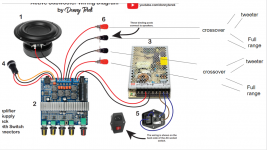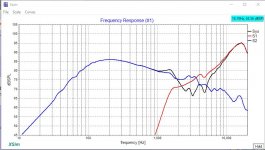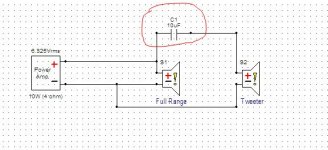I am novice/beginner speaker builder.
I have built a subwoofer with built in amp and a pair of 2 way bookshelf speakers. I followed a YouTube video for the sub so those components should be ok.
Here are all of the components I used:
Subwoofer - Tang Band W5-1138SMF 5-1/4" Paper Cone Subwoofer Speaker
Amp - TPS3116D2 Class D 2.1 Bluetooth 5.0 Amplifier Board 2 x 50W + 100W with Filter and Volume Controls
Tweeters - Peerless by Tymphany BC25SC06-04 1" Textile Dome Tweeter
Midrange driver - Dayton Audio RS100-4 4" Reference Full-Range Driver 4 Ohm
Pre built crossover - Dayton Audio XO2W-4.5K 2-Way Speaker Crossover 4,500 Hz
My issue is over powering bass both from the subwoofer and from the speakers/drivers (the larger issue is the overpowering bass on the drivers because I can turn down the sub channel bass on the amp). I have an old pair of one way speakers and when plugged into the amp the bass is not overpowering in either the subwoofer or speakers. This is why I am assuming it is the crossover that is causing my issue. Should I have used a woofer and a tweeter with this crossover is stead of a mid range? Are you not supposed to use crossovers with midrange driver? Is this the wrong crossover to use? ( I chose a crossover with the highest frequency so it would give more range to the driver) The two channels are 50 watts and the wattage needed for both tweeter and driver is 50 is this ok? Thanks.
I have built a subwoofer with built in amp and a pair of 2 way bookshelf speakers. I followed a YouTube video for the sub so those components should be ok.
Here are all of the components I used:
Subwoofer - Tang Band W5-1138SMF 5-1/4" Paper Cone Subwoofer Speaker
Amp - TPS3116D2 Class D 2.1 Bluetooth 5.0 Amplifier Board 2 x 50W + 100W with Filter and Volume Controls
Tweeters - Peerless by Tymphany BC25SC06-04 1" Textile Dome Tweeter
Midrange driver - Dayton Audio RS100-4 4" Reference Full-Range Driver 4 Ohm
Pre built crossover - Dayton Audio XO2W-4.5K 2-Way Speaker Crossover 4,500 Hz
My issue is over powering bass both from the subwoofer and from the speakers/drivers (the larger issue is the overpowering bass on the drivers because I can turn down the sub channel bass on the amp). I have an old pair of one way speakers and when plugged into the amp the bass is not overpowering in either the subwoofer or speakers. This is why I am assuming it is the crossover that is causing my issue. Should I have used a woofer and a tweeter with this crossover is stead of a mid range? Are you not supposed to use crossovers with midrange driver? Is this the wrong crossover to use? ( I chose a crossover with the highest frequency so it would give more range to the driver) The two channels are 50 watts and the wattage needed for both tweeter and driver is 50 is this ok? Thanks.
Last edited:
Speakers have different sensitivities... one speaker can be right freaking loud on 1 watt, the next would be lean in and listen quiet. If not matched properly for efficiency you're going to have that problem... or worse.
I have done more research and I believe I have a crossover used for subwoofer. Does any one know what crossover I should buy. Thanks.
The specifications for the drivers in the 2-way bookshelf speakers are added here for consideration.
The RS100 full-range is not more sensitive than the tweeter.
https://www.parts-express.com/pedocs/specs/295-378-dayton-audio-rs100-4-spec-sheet-revised.pdf
https://www.falconacoustics.co.uk/downloads/Vifa/XT25SC90-04.pdf
The RS100 full-range is not more sensitive than the tweeter.
https://www.parts-express.com/pedocs/specs/295-378-dayton-audio-rs100-4-spec-sheet-revised.pdf
https://www.falconacoustics.co.uk/downloads/Vifa/XT25SC90-04.pdf
The crossover is adjustable for 4 ohm or 8 ohm bass drivers, but is fixed at 8 ohm for the tweeter. You are correct in that it is not a good choice for your 4 ohm tweeter.
Dayton Audio - XO2W-4.5K 2-Way Crossover 4,500 Hz
Dayton Audio - XO2W-4.5K 2-Way Crossover 4,500 Hz
Are you running your amp board with the highpass switch on to help attenuate bass from the RS-100? A quick and dirty test would be to disconnect the RS-100 and see if the bass levels drop. If you can - attenuate the treble as much as possible before and after the disconnect to help you focus on the bass. See if the RS-100 is making a difference to the bass, or not.
Another reason for too much bass is boominess from a high sealed Q or badly aligned ported enclosure. Care to provide the enclosure details for both the sub and midrange drivers?
Another reason for too much bass is boominess from a high sealed Q or badly aligned ported enclosure. Care to provide the enclosure details for both the sub and midrange drivers?
Please note that the Dayton Audio RS100-4 is NOT a midrange driver, but is a full-range driver. It will therefore produce lots of bass compared to a dedicated midrange speaker.
Looks like you could benefit from a high pass filter in front of the RS100-4 as Dave Bullet has indicated.
Looks like you could benefit from a high pass filter in front of the RS100-4 as Dave Bullet has indicated.
I switched on the high pass and that seemed to alleviate the bass on the full range drivers. The bass on the sub woofer is still a little overwhelming and I need to turn down the filter a lot at high volumes for it to not get distorted. I'm not sure if this is normal. It is a compact sub. Here are the build plans I followed which includes the dimensions and design of the enclosure.(https://www.instructables.com/id/DIY-Active-Subwoofer-Build-With-Integrated-Amplifi/) I still need some help with the cross over. Should I attempt to design my own or buy a different one? Is there is difference when dealing with a full range speaker? Thanks for your responses.
It is a compact sub. Here are the build plans I followed which includes the dimensions and design of the enclosure.(https://www.instructables.com/id/DIY-Active-Subwoofer-Build-With-Integrated-Amplifi/) I still need some help with the cross over. Should I attempt to design my own or buy a different one? Is there is difference when dealing with a full range speaker? Thanks for your responses.
Did you build an active or passive sub?
Your main amplifier board has a 100 watt output for a passive sub. It will hilariously overload an active one.
No that's not the problem. The W5 is connected directly to the amp output as it should be.
I think what you had is 2 problems. First you needed to set the amp's filters correctly which you did and that seemed to help. But the other problem is the speaker prefab xo you are using. The 8ohm tweeter filter at 4500Hz (2uF + ?mH) combined with a 4ohm tweeter is giving you virtually no output in the HF's at all. So with a low pass filter on the mid as well, all you are hearing is bass - you aren't getting any or hardly any treble from either driver.
To demonstrate, I put your drivers' raw responses into XSim. From what I can see from your xo, it's using 2 x 2uF capacitors. When I add in the inductor values that will give textbook 2nd order xo's ~ 4500Hz, I get the result below. Basically, all bass.
If you disconnect the mid/woofer from the xo in 1 of the speakers and only listen to the tweeter, that will confirm or reject the theory. Crank it up and I suspect you are still not going to hear much of anything.
In general, off the shelf xo's have a low probability of getting things right. Buying another one may or may not solve the problem. You are much better off having someone design a xo that suits your drivers and your box and front baffle design. Post that info and someone might give it go.
I think what you had is 2 problems. First you needed to set the amp's filters correctly which you did and that seemed to help. But the other problem is the speaker prefab xo you are using. The 8ohm tweeter filter at 4500Hz (2uF + ?mH) combined with a 4ohm tweeter is giving you virtually no output in the HF's at all. So with a low pass filter on the mid as well, all you are hearing is bass - you aren't getting any or hardly any treble from either driver.
To demonstrate, I put your drivers' raw responses into XSim. From what I can see from your xo, it's using 2 x 2uF capacitors. When I add in the inductor values that will give textbook 2nd order xo's ~ 4500Hz, I get the result below. Basically, all bass.
If you disconnect the mid/woofer from the xo in 1 of the speakers and only listen to the tweeter, that will confirm or reject the theory. Crank it up and I suspect you are still not going to hear much of anything.
In general, off the shelf xo's have a low probability of getting things right. Buying another one may or may not solve the problem. You are much better off having someone design a xo that suits your drivers and your box and front baffle design. Post that info and someone might give it go.
Attachments
Here is diagram of the wiring. (Sorry about the poor quality)
Thank you, that looks about the way I would do it.
I'm thinking your problem could be either the crossover or wildly mismatched drivers... I see @jreave has made an XSim file... I'll have a look as soon as he uploads it.
In the mean time you can experiment with the connection below... It's a "not a real crossover" crossover but it's used quite a bit in mid-fi and basic setups. You can experiment with the capacitor value along a practical range from 4.7uf to about 33uf to see if you can get decent sound.
Attachments
Last edited:
@jreave ... can you upload your DXO file please ... I'd like to take shot at it.
Sorry, open and closed and not saved.
Sorry, open and closed and not saved.
 Fer shame!
Fer shame! I can get the files for the full range... but need them for the tweeter if you have them...
In the mean time you can experiment with the connection below... It's a "not a real crossover" crossover but it's used quite a bit in mid-fi and basic setups. You can experiment with the capacitor value along a practical range from 4.7uf to about 33uf to see if you can get decent sound.
OOPS... missed the edit window ... I should have specified that you need to use non-polarised (NP) capacitors in this circuit.
Polarised electrolytic capacitors will cause massive distortion which will be audible.
Haven't learned to trace yet?
Well... ummm... uh... no.

Up to about 3 weeks ago it didn't seem necessary... What can I say??
- Home
- Loudspeakers
- Multi-Way
- Crossover issue (I think)


